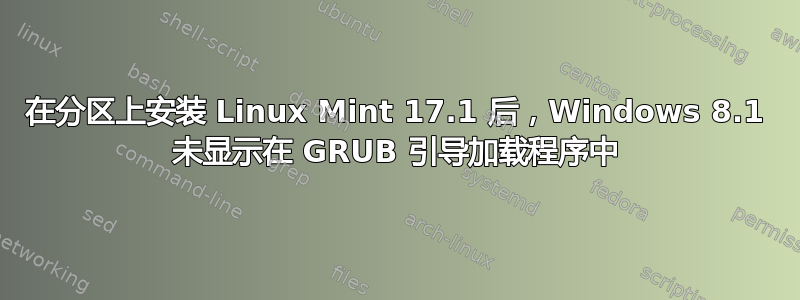
我的系统驱动器基于这些硬件部件
1:SSD 250 GB
2:HDD 1TB
3:外部 HDD 2TB
我将 SSD 用于 Windows 8.1 和所有其他相关的东西,例如安装软件等。HDD 用于在其上安装游戏,而外部 HDD 只是一个外部 HDD。
所以我想做的是,在 Windows 8.1 旁边安装 Linux Mint 17 因为我听说运行 UEFI 的机器可能会出现问题,所以我搜索了一个教程来正确执行此操作。
我用了这个教程在这里。我将 SSD 缩小了 60GB,从 USB 启动 Linux Mint 并安装了它。
根据教程,我将可用空间分为三部分
SWAP -> 4GB
EXT4 in path / -> 20GB
EXT4 in path /home -> 36GB
教程说,我应该将引导加载程序安装在显示 efi 的分区中。然而,没有这样的分区,所以我用我剩余的未使用空间自己创建了一个。 (也许,这就是问题所在)
然后我安装了 Linux Mint,现在可以毫无问题地使用它。但是,我无法返回 Windows 8.1。
当计算机启动时,我按 F8 选择启动设备,然后选择 Win 8 所在的 SSD,收到错误消息
This is not a bootable disk. Please insert a bootable floppy
有些人告诉我,我需要从 grub 加载程序中选择 Win 8,而不是从设备选择器中选择。
当我反复按下时,ESCgrub 加载程序就会出现,但其中只有 Linux Mint。
然后我做了如下:我再次启动到 live CD(使用 USB 记忆棒)并执行这些命令
sudo add-apt-repository ppa:yannubuntu/boot-repair &&
sudo apt-get update &&
sudo apt-get install -y boot-repair &&
boot-repair
然而,这样做的唯一作用是,我现在在引导加载程序中拥有“Ubuntu”而不是 Linux Mint,为什么会这样呢。
然后,我尝试更新grub。这是输出
sudo update-grub2
[sudo] password for tzfrs:
Generating grub configuration file ...
Found linux image: /boot/vmlinuz-3.13.0-44-generic
Found initrd image: /boot/initrd.img-3.13.0-44-generic
Found linux image: /boot/vmlinuz-3.13.0-37-generic
Found initrd image: /boot/initrd.img-3.13.0-37-generic
No volume groups found
Adding boot menu entry for EFI firmware configuration
done
我还尝试了 update-grub 而不是 update-grub2
这是我的 grub 配置文件
# If you change this file, run 'update-grub' afterwards to update
# /boot/grub/grub.cfg.
# For full documentation of the options in this file, see:
# info -f grub -n 'Simple configuration'
GRUB_DEFAULT=0
#GRUB_HIDDEN_TIMEOUT=0
GRUB_HIDDEN_TIMEOUT_QUIET=true
GRUB_TIMEOUT=10
GRUB_DISTRIBUTOR=`lsb_release -i -s 2> /dev/null || echo Debian`
GRUB_CMDLINE_LINUX_DEFAULT="quiet splash"
GRUB_CMDLINE_LINUX=""
# Uncomment to enable BadRAM filtering, modify to suit your needs
# This works with Linux (no patch required) and with any kernel that obtains
# the memory map information from GRUB (GNU Mach, kernel of FreeBSD ...)
#GRUB_BADRAM="0x01234567,0xfefefefe,0x89abcdef,0xefefefef"
# Uncomment to disable graphical terminal (grub-pc only)
#GRUB_TERMINAL=console
# The resolution used on graphical terminal
# note that you can use only modes which your graphic card supports via VBE
# you can see them in real GRUB with the command `vbeinfo'
#GRUB_GFXMODE=640x480
# Uncomment if you don't want GRUB to pass "root=UUID=xxx" parameter to Linux
#GRUB_DISABLE_LINUX_UUID=true
# Uncomment to disable generation of recovery mode menu entries
#GRUB_DISABLE_RECOVERY="true"
# Uncomment to get a beep at grub start
#GRUB_INIT_TUNE="480 440 1"
然后,我尝试按照以下方式手动添加它本教程,但我已经陷入了步骤 1,我应该使用此命令找到我的 EFI 分区
sudo parted /dev/sda print | grep -i efi
但是,没有任何输出。我也换了/dev/sda别的东西,但还是没有。当我输入 df -aTh 时,我什至没有看到任何称为 EFI 的东西。那么,这个 efi 东西到底在哪里,以便我可以继续本教程?
这是的输出df -aTh
Filesystem Type Size Used Avail Use% Mounted on
/dev/sdb6 ext4 19G 6,8G 11G 40% /
proc proc 0 0 0 - /proc
sysfs sysfs 0 0 0 - /sys
none tmpfs 4,0K 0 4,0K 0% /sys/fs/cgroup
none fusectl 0 0 0 - /sys/fs/fuse/connections
none debugfs 0 0 0 - /sys/kernel/debug
none securityfs 0 0 0 - /sys/kernel/security
none efivarfs 0 0 0 - /sys/firmware/efi/efivars
udev devtmpfs 7,8G 12K 7,8G 1% /dev
devpts devpts 0 0 0 - /dev/pts
tmpfs tmpfs 1,6G 1,6M 1,6G 1% /run
none tmpfs 5,0M 0 5,0M 0% /run/lock
none tmpfs 7,9G 21M 7,8G 1% /run/shm
none tmpfs 100M 12K 100M 1% /run/user
none pstore 0 0 0 - /sys/fs/pstore
/dev/sdb7 ext4 36G 1009M 33G 3% /home
binfmt_misc binfmt_misc 0 0 0 - /proc/sys/fs/binfmt_misc
systemd cgroup 0 0 0 - /sys/fs/cgroup/systemd
gvfsd-fuse fuse.gvfsd-fuse 0 0 0 - /run/user/1000/gvfs
/dev/sdc1 vfat 30G 1,5G 28G 6% /media/tzfrs/KINGSTON
那么,有谁知道如何让 Windows 8.1 再次进入我的引导加载程序?我可以在 Linux Mint 中看到 Windows 的 SSD 分区,所以它是 def。还在那儿。
答案1
我不是引导问题的专家,但恐怕你是对的并且搞乱了引导加载程序的安装(GRUB)与 efi 分区!
我在使用 efi 的设备上安装从来没有遇到过问题。只需阅读发行说明并关闭secureBoot!
我建议你安装 GRUB超级GrubDisk在安装 Windows 和 Linux 的硬盘(在您的情况下为 SSD)的 MBR 中(我猜这是第一个名为“sda”的硬盘)。
或者,如果这太复杂并且不需要太多工作,请重新安装 Linux 并将引导加载程序放在“sda”上!
关于安装和双引导系统的一些建议:
答案2
首先搜索所有可能性,然后只应用这个。
制作 live mint cd/usb 腾出空间,用 live mint 启动,安装在包含 win 8.1 的硬盘上的单独部分,启动到 win 8.1 按住 Shift 键“重新启动”转到命令窗口,运行 diskpart,运行选择磁盘,运行选择 vol 包含薄荷,运行活跃 1/2/3(vol cotains 薄荷。你完成了


